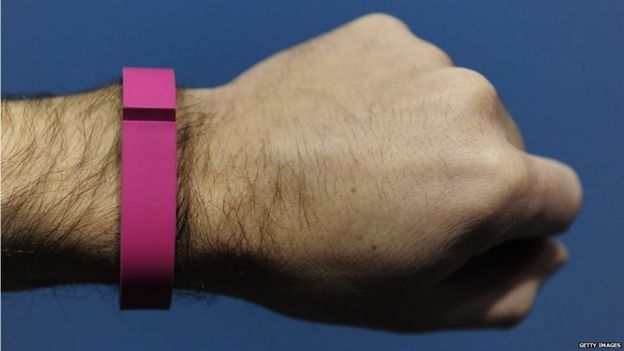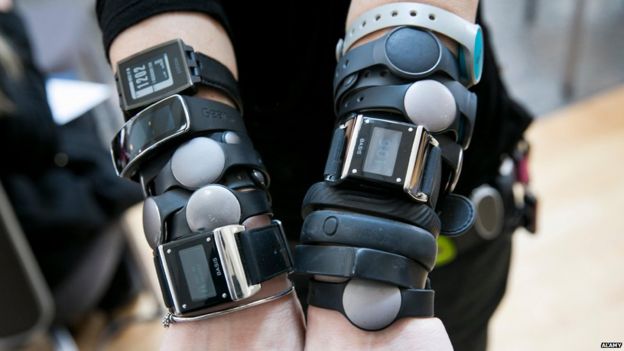 Fitbit and other fitness trackers set a default goal of 10,000 steps a day. But just how valid is this aim if you’re trying to stay active, asks Chris Stokel-Walker.
Fitbit and other fitness trackers set a default goal of 10,000 steps a day. But just how valid is this aim if you’re trying to stay active, asks Chris Stokel-Walker.
Late in the day, as you take a step, your wrist starts buzzing. Congratulations. You’ve hit your target.
Fitbit, which is going public, makes wearable devices that track your fitness levels, such as calories burned and distance travelled. You can customise it, but the default goal is 10,000 steps each day.
That vibration as you reach the landmark figure is «oddly rewarding», says Nath Buck, 26, a media support officer who has been using Fitbit for just over a year.
«I initially bought it purely out of curiosity to see how active I was,» he says. Now he’s convinced his flatmate and three colleagues to invest in similar gadgets and competes with them to see who can walk the furthest fastest.
The market for wearable fitness tracking devices is big business, with the number produced expected to increase from 17.7 million in 2014 to 40.7 million this year. According to research firm IDC, more than 100 million fitness devices that fit on your wrist like a watch will be sold across the globe by 2019.
A third of such devices currently sold are manufactured by Fitbit, and a further 4% by Jawbone, a competitor. Its default goal is also 10,000 steps — roughly equivalent to around five miles each day.

The Misfit Shine tracker sets users a target of 1,000 points, equivalent to around 10,000 steps. Azumio’s Argus fitness tracking app for the iPhone sets targets for the number of steps users should take at between 8,000 to 10,000 per day.
So where does the magic number come from? It’s believed that the concept of 10,000 steps originated in Japan in the run-up to the 1964 Tokyo Olympics, says Catrine Tudor-Locke, an associate professor at the Pennington Biomedical Research Centre at Louisiana State University.
Pedometers became all the rage in the country as Olympic fever swept through Japanese society. One company came out with a device called a manpo-kei, which means 10,000 step meter.
«It was a business slogan, like ‘Just Do It’ for Nike, but it resonated with people,» Tudor-Locke says.
Since then 10,000 steps has become a commonly-acknowledged goal for daily fitness across the world. Various targets around that figure have been published by public bodies.
Japan’s Ministry of Health, Labour and Welfare, for example, recommends «a daily walk of 8,000 to 10,000 steps». The UK National Obesity Forum says that a person who walks between 7,000 to 10,000 steps a day qualifies as «moderately active».

The target appears to be a relatively arbitrary figure. Human, another iOS app, inspires users to be active for 30 minutes a day instead. But the 10,000-steps-a-day goal does have some basis in scientific advice.
Both the UK’s National Health Service and the US Centers for Disease Control and Prevention have a «gold standard» of 150 minutes a week of moderate activity, which is about 8,000 steps a day, says Laura Williams, a diet and fitness expert.
«Someone somewhere has cobbled together an extra 2,000 steps onto the target,» she believes.
This could be because 10,000 steps is «a nice, round number» — much like Malcolm Gladwell’s much-lauded promise that 10,000 hours of practice in any field is sufficient to make you an expert — even if the reality is much more nuanced.
It «latches onto people better than the vague 7,000 to 8,000 number», says Williams. As well as being easily digestible, it’s challenging while also realistic.
«For most people, 150 minutes of exercise a week sounds like an awful lot,» she adds.

But the 10,000 steps figure need not be taken too literally. For one thing, not all steps are equal.
As Dale Esliger, a senior lecturer in the measurement of physical activity at Loughborough University, explains: «If you’ve got short or long legs there are differences there.»
For a long-legged woman, 10,000 steps is unlikely to be as tough as it would be for someone shorter. Plus people’s gaits differ as much as their eye colour or personalities.
Besides, a device on your wrist recording digital motion in your legs is not infallible. Some of those 10,000 steps recorded on your fitness tracker might include you bending down to tie your shoelaces, says Esliger.
«The best kind of device to track steps taken is one placed on the ankle, looking for an actual step biomechanically,» notes Esliger.
According to the NHS, the average Briton walks between 3,000 and 4,000 steps a day — significantly less than the Fitbit target. Yet many people do significantly more, and for them 10,000 steps might not be much of a target.
«If you run three times a week, you’re not going to get fitter by walking 10,000 steps,» Williams explains. «You’re already quite fit. You’re going to need to do more to get fitter than someone who is chronically unfit and inactive. For them, walking 5,000 or 10,000 steps a day will improve their fitness.»
Wearable devices instead offer people a challenging goal they can attain to, and a simple-to-understand baseline roughly equivalent to the minimum suggested amount of exercise.

Buck, for example, swims and runs regularly, and is unlikely to be challenged by 10,000 steps — yet still keeps his target at that level. «I’ve thought about changing it but 10,000 seems a good ‘basic’ target to reach,» he says. «You know you’re doing at least the minimum then.»
To reach 10,000 steps you have to create some structure in your walking routine, says Williams. That might involve walking a mile one way and a mile another when you go out for lunch.
«If you do too little, like park two car parking spaces further away from the supermarket entrance, you’re not going to reach the target,» she says. «You also need to make sure you keep challenging yourself. Pace and intensity is key to getting fitter.»
Tudor-Locke agrees that the 10,000-step target is «laudable». She says: «Go for it if you want to. In fact, go for 12,000 — go to 14,000. There is no limit we know of that is detrimental to health.»
But, she warns, don’t treat it as an absolute target. «Rather than be obsessed with a number,» she says, «it’s just important to not be sedentary.»
And though you may feel triumphant upon reaching your 10,000 step target, remembering that snaffling a chocolate cake will undo the day’s work is vital, too.

More from the Magazine

A number of recent books have lauded the connection between walking — just for its own sake — and thinking. But are people losing their love of the purposeless walk?
http://www.bbc.com/news/magazine-33154510


